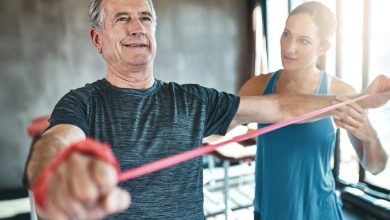Fitness & WellnessHealthy LifestyleToday’s Trends
Step-Ups: Not As Simple As They Look

While it may sometimes be challenging to see immediately how some resistance exercises translate in real life, it certainly isn’t the case with step-ups. After all, we do some on an everyday basis simply climbing up stairs, don’t we?
Step-ups seem like a really simple exercise, but there are a couple of tricks to performing them properly, which not only makes them feel a lot harder, but makes them much more effective too.
What Are the Benefits of the Step-Up?
Overall, step-ups help develop strength and stability through your lower body and core. You can choose to perform step-ups with different goals in mind, depending on your overall technical ability and skill level, the amount of added weight you use, the set and rep scheme you select, where the step-ups are placed in your workout, what other exercises they’re paired with and what your rest periods are.
In general, step-ups can be used to do any or all of the following:
- Build lower body strength.
- Build muscle.
- Fat loss (if your diet and exercise routines are conducive to fat loss).
- Conditioning (if used as part of conditioning circuits).
What Equipment Do You Need?
 You’ve certainly figured out by now that you need a surface to step onto. This can be a stable box, step, or bench. Step-ups can be done at varying heights, but a good guideline is to always start lower than you think you should. It’s important that you’re able to control your hips throughout the whole movement, and not let your hips kick out to the side, which tends to happen if you select a surface that’s too high.
You’ve certainly figured out by now that you need a surface to step onto. This can be a stable box, step, or bench. Step-ups can be done at varying heights, but a good guideline is to always start lower than you think you should. It’s important that you’re able to control your hips throughout the whole movement, and not let your hips kick out to the side, which tends to happen if you select a surface that’s too high.
To add resistance, you can hold on to dumbbells or kettlebells. If you’re using a single kettlebell, hold it by the horns in the goblet position, with the weighted part hanging down. You can choose a similar hold with a single dumbbell, with both hands holding one of the ends.
If you’re using two dumbbells or two kettlebells, you can either choose to hold them at your sides (be careful not to swing your arms) or hold them at your shoulders in the rack position.
What’s the Proper Technique?
You should focus on the step-up technique before choosing to add more resistance. As I mentioned earlier, they seem easier to perform than they actually are, and a proper technique will go a long way to help you reap all the benefits of the exercise.
When you choose to add extra weight, find something that feels challenging to you (remember that “challenging” is unique to the individual) yet still allows you to complete all your intended reps while still feeling you could complete a few more with proper form.
Set Yourself Up
 Place a box or bench in front of you (remember, start a little lower than what you think you can step onto).
Place a box or bench in front of you (remember, start a little lower than what you think you can step onto).- Place your entire foot on the surface, directly in front of your hip.
- Check the alignment of your hips to make sure one isn’t kicking out to the side.
- Brace your abs and think about keeping your ribs down toward your hips as you initiate the movement.
- Remember that you want to avoid pushing off with your bottom foot.
The Movement
- Drive through the heel of the foot on the box and pull yourself into standing position by contracting your glutes and quads.
- Make sure you are keeping your hip and knee stable as you step up (there should be no side to side movement).
- Keep the same foot on the box as you you lower your free leg back to the ground (during this phase, it’s OK to lean your torso forward just slightly, but remember to keep your abs braced, and pelvis tucked slightly).
- Throughout the entire step-up, try to keep your hips and shoulders level.
When Should One Perform Step-Ups?
As a main lower-body exercise, step-ups should be performed toward the beginning of a workout, as you’re still fresh and your technique is less likely to falter. More advanced lifters can also use step-ups as an accessory exercise for deadlifts.
If your goal is strength, repeat all reps on one leg and then switch and repeat all reps on the other leg. Alternating legs and doing reps for time will make it more of a cardiovascular exercise, which may be appropriate in a conditioning circuit.





